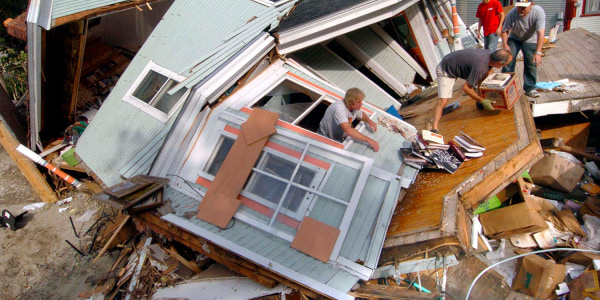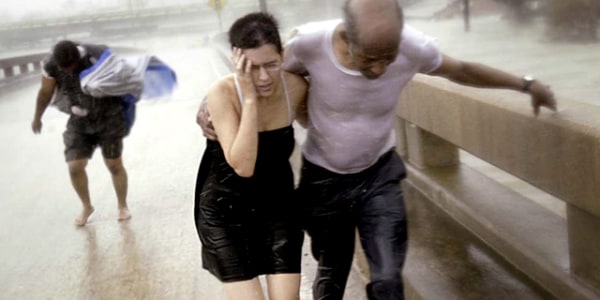After the storm that caused at least 41 deaths and billions of dollars in damage as it rampaged from the Caribbean to Vermont, is it time to say “Good night, Irene”? It will take several months to find out, but judging by the retirement of the names of past hurricanes that will live in infamy, there is a good chance that the name “Irene” will never be used to label a storm again. Since 1954, the Geneva-based World Meteorological Organization has annually retired the names of certain hurricanes if they result in numerous deaths or wreak such horrendous damage that using the name to label a future storm would be considered insensitive to those greatly affected by the previous one. For example: Mention the names “Katrina,’’ “Andrew’’ or “Hugo’’ in certain parts of the country, and traumatic memories are almost certain to be triggered. That is why those three are no longer part of the alphabetical lists of storm names that rotate every six years for the Atlantic Ocean region.
The Tropical Cyclone Committee for the WMO meets annually in March to review the previous hurricane season, which runs from June 1-Nov. 30 in the Atlantic and May 15-Nov. 30 for the eastern Pacific. Part of the meeting includes deciding to retire the names of any particular hurricanes from the previous season. “Retiring names is one small part of the agenda, and since it’s still relatively early on in the current hurricane season, it’s too early to say (if the name Irene will be retired),’’ WMO press officer Clare Nullis told TODAY.com. Names of infamy
However, judging by the two hurricane names that were retired from the 2010 season, it’s a good bet that we will never see another Hurricane Irene — which is probably a pleasant thought to those with trees through their roofs and water in their basements right now. At the most recent WMO committee meeting on March 8-12 in the Cayman Islands, the names Igor and Tomas were retired after reviewing the 2010 hurricane season. They were replaced by Ian and Tobias on the rotating list.
Hurricane Igor was a Category 4 storm at one point before weakening to Category 1 as it hit Bermuda and then made landfall near Newfoundland, Canada, in September 2010. The hurricane killed three people and caused nearly $200 million of damage.
Hurricane Tomas was a Category 2 storm when it hit St. Vincent and St. Lucia in October 2010 and then weakened to Category 1 when it slammed into part of Haiti. Fourteen people were confirmed either missing or dead from the storm on St. Lucia, and 35 died in Haiti because of mudslides triggered by the storm. The damage was estimated at just under $500 million.
Slideshow 150 photos
Hurricane Irene
Given that Irene was a Category 1 hurricane that caused damage in the billions and killed at least dozens of people, it was far more destructive than the two that were retired in 2010. That means it’s a good bet that the WMO committee will be saying farewell to the name “Irene’’ in March 2012. Why no Frieda?
The committee was formed in 1950, and since 1954, 75 hurricane names, from Agnes to Wilma, have been retired after causing havoc in the Atlantic, Caribbean and Gulf of Mexico regions. There have been 18 years where no hurricane names in the region have been retired, and some were taken out of circulation without even being destructive. (In 1966, “Fern’’ replaced the name “Frieda’’ on the list, and no reason was given, according to the WMO.)
The practice of naming hurricanes began in the 1950s as a shortcut to be used in communications between coastal bases and ships, as well as in warnings and media reports on the storms, rather than using the more complicated latitude and longitude numbers and technical terms. Since 1953, the Atlantic storm names have originated from a list produced by the National Hurricane Center in Miami and are maintained and updated by the WMO committee. Before the 1950s, the names were assigned randomly. For example, when a storm tore apart a schooner named “Antje” in 1842, it was referred to as Antje’s Hurricane. In the 1950s, meteorologists began using an alphabetically arranged list of names that were all feminine; men’s names were introduced in 1979.
Slideshow 29 photos
America's worst hurricanes
Men’s and women’s names for storms now alternate, and six lists of names are used in a rotation in the Atlantic region. So the list from 2010 will be used again in 2016, except that the names “Igor’’ and “Tomas” have now been replaced by “Ian’’ and “Tobias.’’ There are rotating lists for each of the 10 regions worldwide, which include places like the Eastern North Pacific, Central Pacific, South China Sea, Australia and Indonesia. The names are also region-specific, so you might see a Hurricane Wukong in the South China Sea or a Hurricane Iggy in Australia. As for the rest of the current hurricane season in the Atlantic, “Jose’’ and “Katia’’ are next on the list after Irene, with “Lee’’ and “Maria’’ right behind them. Many of the hurricane names retired over the years are ones that have seemingly also been retired in everyday life. You don’t run into too many people named “Hortense’’ (1996), “Hattie’’ (1961) or “Ione’’ (1955) these days.
And while past hurricanes had actually inspired more parents to name their children after them, the immense devastation of Hurricane Katrina in New Orleans in 2005 may be reversing that trend. “Katrina’’ plummeted from the 281st most popular baby name in the United States in 2004 to the 815th most popular name in 2009, according to the Social Security Administration.

